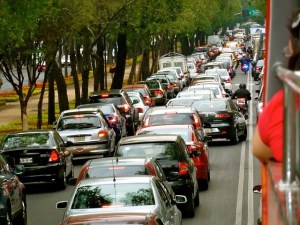European Parking Policies Leave New York Behind

Flashback to Europe, sixty years ago. Just emerging from the ruin of total war, the continent was in the midst of a nearly unprecedented reconstruction. Over the next decade, industry finally was able to turn toward consumer products, from stockings to refrigerators and, of course, the automobile. Italians owned only 342,000 cars in 1950, but ten years later that number had increased to two million, according to historian Tony Judt. In France, the number of cars tripled over the decade.
With mass car-ownership fundamentally new for Europe, parking policy was practically non-existent. The first parking meter — an American invention — only made it to Europe in 1958, arriving in front of the American embassy in London. In most places, cars could park not only for free but wherever they wanted: on the sidewalk, in a public square.
When they realized that simply giving drivers free rein to park anywhere was untenable, Europeans attempted to build enough parking to meet the population’s galloping demand. Public space, from sidewalks to canals, was turned into parking space. Zoning forced all new development to use money and space for parking. All these concessions, however, only made European cities friendlier to cars and further drove up demand.
Today, however, all that is in the past. As outlined in the new report from the Institute for Transportation and Development Policy, “Europe’s Parking U-Turn: From Accommodation to Regulation,” the continent is now leading the world when it comes to innovative, intelligent and sustainable parking policy [PDF].
Across Europe, cities have come to understand that oversupply or subsidy of parking leads to too much driving. The effect is considerable. In Vienna, for example, when the city began to charge for on-street parking, the number of vehicle kilometers traveled plummeted from 10 million annually to 3 million. In Munich, the introduction of a new parking management system has resulted in 1,700 fewer automobiles owned in the city center each year since 2000.

Looking across the Atlantic offers a wide array of strategies to manage parking more effectively.
- Free daytime parking was eliminated completely in Munich. 95 percent of Paris’ roughly 50,000 free parking spaces were converted to paid spaces.
- Too often, the decision of how much parking to provide is disconnected from any other city goals. Not in Zurich. Under the terms of the city’s “Historischer Parkplatz Kompromiss,” each development is assigned a cap on the number of trips that can be made by car, which is controlled by the amount of parking provided onsite. The cap is determined by looking at the congestion and air quality in the immediate area.
- Parking maximums have replaced parking minimums in cities such as Zurich, Amsterdam and Strasbourg. The Swiss, Italian and British governments all recommend that local governments use maximums, in the words of the British government, to “promote sustainable transport choices, reduce the land-take of development, enable schemes to fit into central urban sites, promote linked-trips and access to development for those without use of a car, and to tackle congestion.”
- The idea behind parking minimums for commercial space is to ensure that employees of a new development don’t fill up all an area’s parking spaces. Logically, therefore, Hamburg decided that if enough employees at a company had a transit pass, that company should have to reduce the amount of parking it provides.
- Hard caps on the amount of parking downtown are in place in Hamburg, Zurich, and Budapest. No one can build a new off-street space unless the city agrees to take away an on-street space. Despite rising prosperity and car ownership, the number of parking spaces in the center of Hamburg has remained at 30,000 since 1976.
- Regulating parking only works if those regulations are enforced, a job that Europeans have made easier through new technology. Across France, magnetic sensors are employed to determine when cars overstay time limits. Amsterdam uses a fleet of vans with license plate-reading cameras to track violations.
- On-street parking rates better reflect market demand. In London, rates go up to £4.40 an hour ($7.04), and in Amsterdam up to €5 ($6.75). In New York City, by comparison, rates only go up to $3.75.
- Parking management has been closely tied to Europe’s largest bike-sharing systems. In Paris and Barcelona, bike-sharing stations replaced thousands of on-street spaces, and in Barcelona, all parking revenue goes directly to supporting bike-sharing.
Across Europe, there appears to be a much heavier emphasis on providing residential parking permits, public-private partnerships to operate the parking system, and technological conveniences like pay-by-phone parking.
Cities like London and Paris are New York City’s competitors. While they move forward with these innovative programs, New York still forces its drivers and bus riders to sit behind a line of traffic cruising for a rare open space or holding out for one of the city’s many free on-street spaces. New York tacks the cost of unwanted parking onto every new office and residence. In commercial zones, meanwhile, parking spaces are commandeered for hours, reducing turnover and making deliveries a hassle. Not to mention the environmental and safety disasters of encouraging all those extra car trips.
The Mayor’s Office is thinking about tackling parking policy in this spring’s update of PlaNYC, and hopefully they’ll use this ITDP report to adapt some of Europe’s best ideas. Then again, they just bowed to motorist influence in the City Council over raising meter rates by just a quarter. Giving New York City’s parking policy the same U-turn that Europe took will apparently be quite the political lift.
